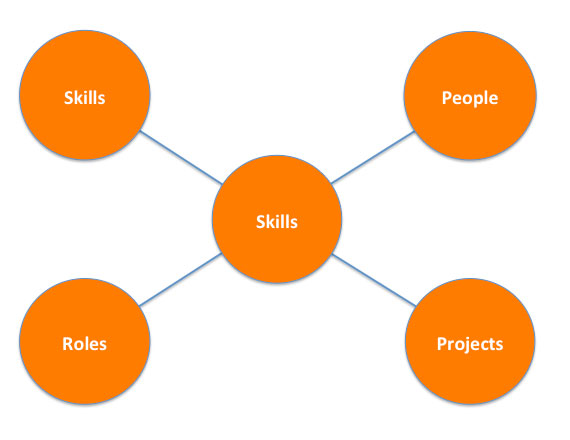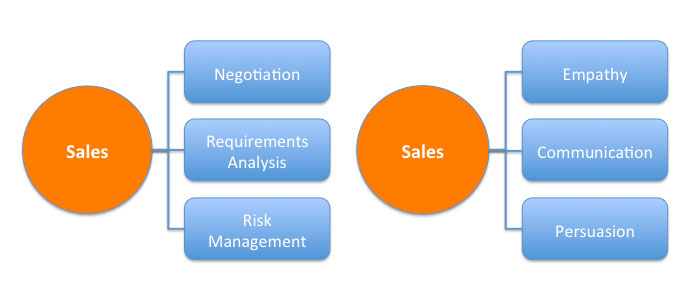Even if you have the skills, can you connect them?
Steven Forth is a co-founder of TeamFit. See his TeamFit skill map here.
Skills are percolating to the top of the corporate agenda. Leaders understand that their organizations will only succeed if they have the people with the skills to deliver the vision. As a result, more and more companies are investing in skill and expertise management as a critical capability. Companies that cannot answer the key business questions about skill management are setting themselves up for failure.
What does skill management mean? It is more than a list of skills and competencies, even if these are organized into a complex taxonomy. Skills become actionable when they are connected.
Key actions enabled by skill and expertise management
Which people to put together on teams
Which skills to invest in for differentiation
How to develop people for specific roles
What lines of business to develop based on untapped potential
There are four critical types of connections that skill management must address if it is to give actionable insights. Skills need to be connected to other skills, to people, to roles and to projects. From these four types of connections, one can also connect skills to potential and to outcomes.

Skills to skills: Parent & Child, Associated & Complementary, plus Connecting
There are many different relationships between skills, and a good skill management system will have a data model that let's you capture and express these. Parent skills are higher level or more general skills that are composed of multiple child skills. Not all the Child skills need to be present for any individual, and the pattern of child skills says a great deal about how a person will go about applying a parent skills. Here are two different sales people.

Each of these people will take a very different approach to sales. The person on the left will be the classic 'bag carrying' sales person who expects to 'carry a number.' The person on the right will be more of a customer coach, that helps the customer in many ways leading them to buy.
Two other critical skill relationships are Associated skills and Complementary skills. Associated skills are skills that we expect to find together in the same person. If a person has a skill of HTML5 we expect them to also have CSS and are surprised if they do not. Complementary skills are even more interesting. These are skills that are not generally found in the same person, but which are frequently used together. Some examples are data analysis and data visualization or user experience (UX) and front-end engineering.Skill connections can be context dependent. One type of skill is Connecting skills. These come in two flavors, Internal Connecting skills and External Connecting skills. Connecting skills are those that we use to integrate other skills and to underpin communication. When working with a new person it is a good idea to quickly get a feel for your connecting skills.
Skills to people: Communities of Practice, Mentors and Mentees and Project Teams
Connecting skills opens up the whole question of how skills connect people together into skill networks. There are three critical relationships here: shared skills, mentoring and complementary skills.
People with shared skills will often want to band together to create communities of practice, where they can help each other to deepen their expertise. One emerging use of skill management platforms is to help people in distributed work-forces find the other people who share their interests.
Many of us have skills that we are trying to improve. On TeamFit, these are represented as Target skills. One of the best ways to develop a new skill is to find a mentor, a person who already has the skill and who is willing to be your guide. We are planning to let people note which skills they are willing to act as mentors on to make it easier for people to find mentors (mentors and mentees need to have Connecting skills as well, so they will have a foundation for communication).
Finding people with skills that are Complementary to your own is critical to your career. Many of us have a group of people we like to work with. When these groups are successful they generally have a good mix of Complementary and Connecting skills.
Skills to projects
In today's world, much of our work is done on projects, and pulling together successful project teams is critical to success. In many cases, these are cross-functional teams that combine people with very different skill sets. Cross functional teams are critical for things like innovation and market shaping. In their November 2017 article in Strategy & Business, 'Reimagining Effective Cross-Functional Teams' Sally Blount and Paul Leinwand call out a set of best practices for team assembly. One of the best practices they call out is Knowledge Transfer, which at TeamFit we would refer to as Skill Building. More than any formal training, teams are where we learn new skills and build capabilities. This is a good example of 702010 learning, where 70% of what we learn comes from our experiences. Today, most of those experience take place on teams.
Skills to roles
Many of us want to grow in our careers so that we can take on new roles. To do this, we need to know what skills we need for specific roles and how to build up to them. We also want to have a record that shows that we have developed the skills we need to take on new roles.

In the past, this was done top down, with complex competency models that rigidly defined the skills needed for roles. This heavy handed approach does not work in today's world. It makes more sense to see the different skill patterns associated with roles and to see how skills transfer from one role to another. This is the approach we are taking at TeamFit. To take one example, there are many people who are project managers who want to become product managers. Our research has found that about 40% of product managers have been project managers at some point in their career. Project management skills are important for many product mangers, but they are only a small subset of the skills that a product manager needs, and in many cases the project management aspects of product development work are supported by dedicated project manager.
Uncovering potential
At the end of the day, the work of connecting skills has one overarching goal: to discover potential and finding ways to put it to work. Potential can be hidden in many places. In some cases we have skills that we are not applying. If those skills are invisible to others they can't reach out to you and engage around them. We also have Potential skills, those skills that we don't yet have but could pick up relatively easily based on our Foundational skills (those skills we use to build other skills) and the various practical skills in our repertoire. From an organizational perspective, potential is often found not in the skills of one individual, but by combining people in new ways, using matches for Complementary skills and Connecting skills.
TeamFit's data model supports all of these skill relationships. If you are considering adopting a skill and expertise management system, you should have the vendor walk through the data model to see if they will be able to connect skills in the ways that matter to your business. Of course, the data model by itself is just a place to hold data. A skill and expertise management system needs to go beyond this and have algorithms that find the connections between skills and ways for the user to discover those connections.


